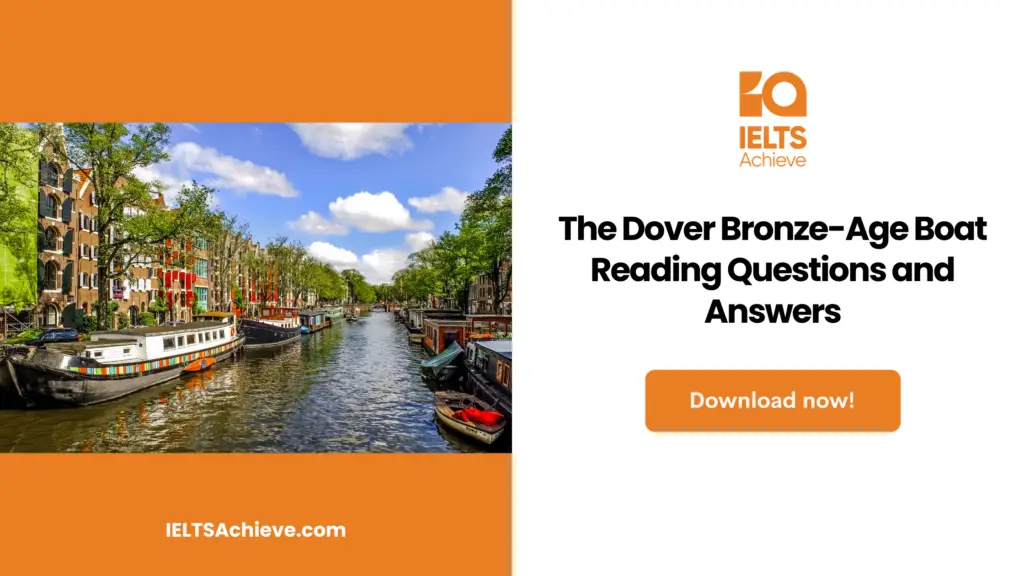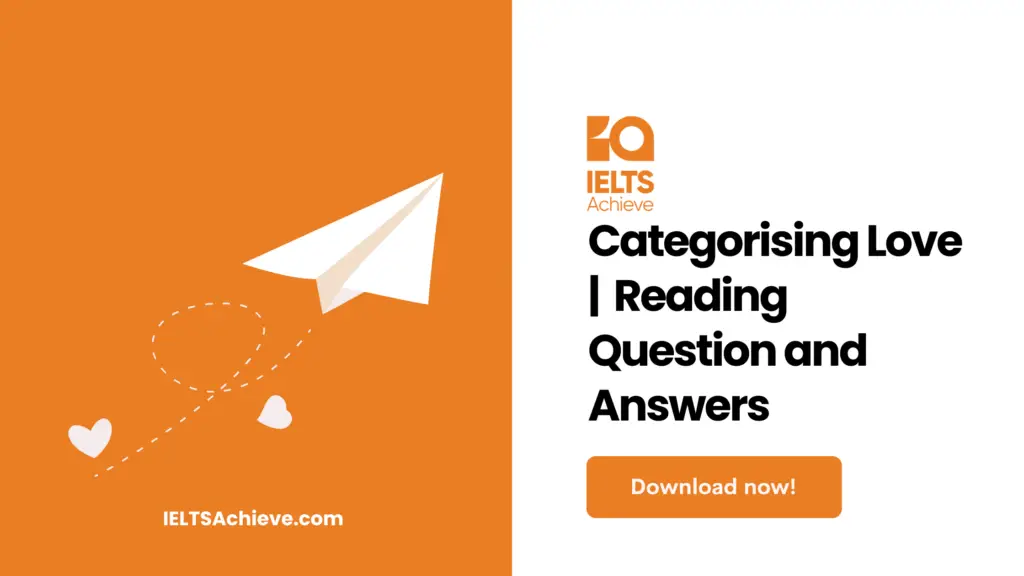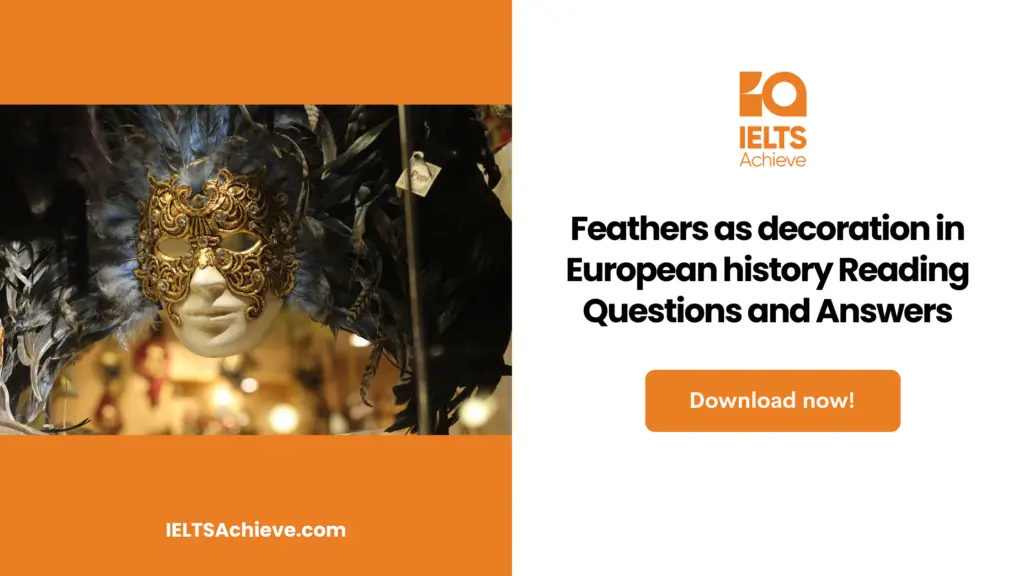The Blog post contains the following IELTS Reading Questions:
- IELTS reading Flowchart Completion
- IELTS reading Short Answers Questions
- IELTS reading True/False/Not Given
Stay informed and prepared for success – Explore our comprehensive Reading Test Info page to get valuable insights, exam format details, and expert tips for mastering the IELTS Reading section.
IELTS Academic Reading Passage: The Dover Bronze-Age Boat

The Dover Bronze-Age Boat
A gorgeously conserved boat, made around 3,000 years ago and ascertained by possibility in a waterlogged hole, has had a heartfelt collision on excavation research.
It was 1992. In England, workers were building a new road via the heart of Dover to attach the former port and the Channel Tunnel, which, when it unlatched just two years later, was to be the first land link amid Britain and Europe for over 10,000 years. A small group from the Canterbury Archaeological Trust (CAT) toiled among the workers, recording new discoveries that fetched light by the apparatus.
At the base of the deep pole six meters beneath the modern streets, a ligneous structure was divulged. Cleaning away the soggy spot coating the logs, the paleontologist noticed its true nature. They had found a primitive boat, conserved by the debris in which it was covered. After, it was named Dover Bronze-Age Boat.
About 9 meters of the boat’s extent was recuperated; one end lay above the exhumation and had to be left. What bear comprised basically of four intricately sculpt bobber boards: two on the bottom, connected along a central seam by a complex system of chunk and sew to the others. The join had been made airtight through pads of bog, fixed by utilizing wedges and yew stitches.
The wood that closed the recuperate end of the boat had been detached in ancientness when it was deserted, but much about its authentic shape could be concluded. There was also proof of a missing upside board. The boat was not destroyed, but had been intentionally discarded, disassembled and broken. Maybe it had been “sacrificed” at the end of its life,like other Bronze-Age objects.
With recollection, it was notable that the boat was established and studied by a normal paleontologist who was inherently involved in its cultural situation. At the time, antiquated boats were frequently treated only from a cramped high-tech outlook, but news about the Dover boat reached a broad audience. In 2002, on the 10th anniversary of the finding, the Dover Bronze -Age Boat Trust hosted a conference, where this meeting of dissimilar heritages became evident. Beside technical papers about the boat, other announcers explored its social and economic circumstance, and the devout acumen of boats in Bronze-Age societies. Many announcers came from abroad, and argued and discussed about cultural links were renovated.
Enclosed by 7 years of exhumation, the Dover boat had been skimped and exhibited but it was evident that there were issues that could not be determined in short by studying the old wood. Exploratory prehistory appeared to be the solution: a boat remodeling, half-scale or full-sized, would allow evaluation of the dissimilar theory concerning its build and the missing end. The chance of returning to Dover to search for a boat’s unevener northern end was explored, but empirical and monetary troubles were insuperable- and there was no warranty that the logs had lived the foregoing decennary in the swapped background.
Comprehensive proposals to rebuild the boat were formulated in 2004. Excavation proof was originally to suggest a Bronze-Age group bestride the channel, accumulated by the sea, instead of split by it. In a zone today divided by tongue and frontier, palaeologist had a responsibility to inform the populace about their common culture ancestry.
The boat estimate started in England but it was devised from the beginning as a European partnership. Remodeling was only part of a plan that would involve an important show and a large academic and exceed programme. Arguments initiated initially in 2005 with excavation bodies, universities and ancestry organizations on both sides of the channel. There was much eagerness and bear, and an official launch of the plan was held at an worldwide conference in France in 2007. Financial bear was established in 2008 and the plan then named BOAT 1550 BC got under way in June 2011.
A small crew commenced to form the boat at the start of 2012 on the Roman Lawn exterior Dover museum. A complete remodeling of a midriff had been made in 1996, firstly to see how Bronze-Age copy tools performed. In 2012, nevertheless, the hull shape was at the mid of the work, so new hydraulic tools were utilized to sculpt the bobber boards, before turning to primitive tools for finishing. It was distinct to make the copy half-scale for cause of cost and time; any artificial materials were used for the sewing, unpaid to uncertainty about the scaling and compressed timetable.
Meantime, the show was getting ready for launch in July 2010 at the Castle Museum in Boulogne-Sur-Mer. Authorized ‘far flung: societies of the Channel & North sea 3,500 years ago’ it accumulated for the first time an extraordinary assemblage of Bronze-Age objects, including many new analyses for commercial excavation and some of the great value of the past. The rebuilt boat as a symbol of the naval links that leap together the group on both sides of the Channel, was the focal point.
Unlock your full potential in the IELTS Reading section – Visit our IELTS Reading Practice Question Answer page now!
Recommended Questions:
Renewable Energy IELTS Reading Question with Answer
IELTS Reading Questions: The Dover Bronze-Age Boat
Questions 1-5
- Complete the chart below.
- Choose ONE WORD ONLY from the text for each answer.
- Write your answers in boxes 1-5 on your answer sheet.
1992 – the boat was discovered during the construction of a 1……………
2002 – an international 2…………… was held to gather information
2004 – 3……………. for the reconstruction were produced
2007 – the 4…………… Of BOAT 1550 BC took place
2012 – the Bronze-Age 5…………… featured the boat and other objects
Boost your performance in Summary, Notes, Table, and Flowchart Completion tasks. Click here to explore our detailed guide and learn how to effectively complete summaries, notes, tables, and flowcharts in the IELTS Reading section.
Questions 6-9
Do the following statements agree with the information given in the text?
In boxes 6-9 on your answer sheet, write
- TRUE if the statement agrees with the information
- FALSE if the statement contradicts the information
- NOT GIVEN if there is no information on this
6. Archaeologists realized that the boat had been damaged on purpose.
7. Initially, only the technological aspects of the boat were examined.
8. Archaeologists went back to the site to try and find the missing northern.
9. Evidence found in 2004 suggested that the Bronze-Age Boat had been used for trade.
Enhance your skills in identifying information as True, False, or Not Given. Click here to discover expert strategies and techniques for mastering this question type in the IELTS Reading section.
Questions 10-13
- Answer the questions below.
- Choose NO MORE THAN THREE WORDS AND/OR A NUMBER from the text for each answer.
- Write your answers in boxes 10-13 on your answer sheet.
10. How far under the ground was the boat found?
11. What natural material had been secured to the boat to prevent water entering?
12. What aspect of the boat was the focus of the 2012 reconstruction?
13. Which two factors influenced the decision not to make a full-scale reconstruction of the boat?
Unlock your full potential in the IELTS Reading section – Visit our IELTS Reading Practice Question Answer page now!
Recommended Questions:
Renewable Energy IELTS Reading Question with Answer
The Dover Bronze-Age Boat Reading Answers
1. Road
2. Conference
3. Proposals
4. Launch
5. Exhibition(show)
6. True
7. False
8. False
9. Not given
10. 6/ six meters /meters/m
11.(pads of) moss, (pads of bog)
12. (the) hull (shape)
13. Cost and time

We hope you found this post useful in helping you to study for the IELTS Test. If you have any questions please let us know in the comments below or on the Facebook page.
The best way to keep up to date with posts like this is to like us on Facebook, then follow us on Instagram and Pinterest. If you need help preparing for the IELTS Test, join the IELTS Achieve Academy and see how we can assist you to achieve your desired band score. We offer an essay correction service, mock exams and online courses.

